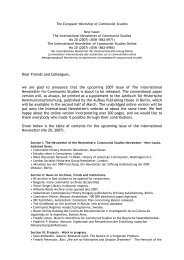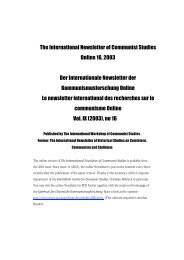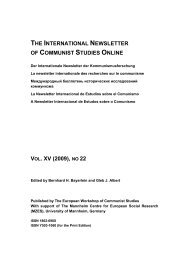Vol. XIII (2007), no 20 - The International Newsletter of Communist ...
Vol. XIII (2007), no 20 - The International Newsletter of Communist ...
Vol. XIII (2007), no 20 - The International Newsletter of Communist ...
Sie wollen auch ein ePaper? Erhöhen Sie die Reichweite Ihrer Titel.
YUMPU macht aus Druck-PDFs automatisch weboptimierte ePaper, die Google liebt.
<strong>The</strong> <strong>International</strong> Newletter <strong>of</strong> <strong>Communist</strong> Studies Online <strong>XIII</strong> (<strong><strong>20</strong>07</strong>), <strong>no</strong> <strong>20</strong> 32<br />
<strong>The</strong> disparity in attention paid to Nazi and <strong>Communist</strong> crimes is itself old news. But in the<br />
problem <strong>of</strong> gold movements, the disparity is <strong>no</strong>t only acute, but injurious to historical<br />
understanding. To begin with, gold sales, and the imports they financed, were much less<br />
important to the Nazi war machine than they were to the Bolsheviks’. <strong>The</strong> eco<strong>no</strong>my <strong>of</strong> Nazi<br />
Germany was entirely functional during even the bleakest war years, producing the vast<br />
majority <strong>of</strong> sophisticated manufactures and armaments essential to the Wehrmacht.<br />
Famously, the I.G. Farben company even perfected the tech<strong>no</strong>logy <strong>of</strong> producing gasoline and<br />
fuel oil from coal. Other strategic materials were obtained by the Nazi war machine through<br />
conquest, as with iron ore in Norway, or by coercing satellites, like Romania with its<br />
petroleum. German gold sales in Switzerland in the early 1940s financed the purchase <strong>of</strong><br />
little more than a few metals from neutral states, like manganese, tungsten and chrome,<br />
admittedly important but hardly dear compared to everything else required by the<br />
Wehrmacht. Had the army <strong>no</strong>t been so rave<strong>no</strong>us, the Nazi government could have simply<br />
traded for these metals with surplus manufactures. Lebor’s $289 million in gold meant a lot<br />
to the occupied governments being looted, but when set against total expenditures by the<br />
German war machine from 1939 to 1945, it is rather small beer.<br />
By contrast, gold was virtually the only moveable asset the Bolsheviks enjoyed for many<br />
years after the Russian Revolution. Eco<strong>no</strong>mic production under the draconian regime <strong>of</strong> “War<br />
Communism” was insufficient to supply even food and fuel to Moscow and Petrograd, let<br />
alone produce surpluses in traditional Russian export sectors such as grain, timber, hemp,<br />
flax, and furs. A country where emaciated urban dwellers were tearing down entire buildings<br />
for wood to heat their apartments was <strong>no</strong>t likely to have export surpluses on hand. In fact,<br />
excepting a few leftover stocks <strong>of</strong> flax and hemp they inherited in 1917, the Bolsheviks had<br />
only confiscated gold, silver, platinum, diamonds, and jewelry to “trade” for desperately<br />
needed imports.<br />
<strong>The</strong> flip side <strong>of</strong> an eco<strong>no</strong>my producing <strong>no</strong>thing worthy <strong>of</strong> export was that the Bolsheviks,<br />
again unlike Nazi Germany, had to import virtually everything their own war machine<br />
required. War needs money, and the Bolsheviks were fighting many different wars in<br />
succession from 1917 to 19<strong>20</strong>, against Whites, Poles, Finns, at times Germans, and Allied<br />
expeditionary forces from Japan, America, France, and Great Britain. Thanks to Orlando<br />
Figes and others, we <strong>no</strong>w k<strong>no</strong>w <strong>of</strong> the ferocious civil war which erupted in the Russian<br />
countryside in 19<strong>20</strong>-1921, as bands <strong>of</strong> peasant partisans and anarchist “greens,” many <strong>of</strong><br />
whom had cooperated with the Red Army against the Whites and foreign troops, turned their<br />
Adventure,” <strong>The</strong> Colophon (New York, 1932). An up-to-date bibliography, including an impressive guide<br />
to related materials catalogued in the New York Public Library, is provided by Robert H. Davis et al, in A<br />
Dark Mirror: Roma<strong>no</strong>v and Imperial Palace Library Materials in <strong>The</strong> New York Public Library: A<br />
Checklist and Agenda for Research (New York: Norman Ross Publishing, <strong>20</strong>00). For details on which<br />
Russian Imperial Art treasures ended up where in American museums, galleries, and private collections,<br />
see, for example, Anne Odom and Liana Paredes Arend, A Taste for Splendor. Russian Imperial and<br />
European Treasures from the Hillwood Museum (Alexandria, Virginia: Art Services <strong>International</strong>, 1998).<br />
In recent years, a traveling exhibition <strong>of</strong> “<strong>The</strong> Jewels <strong>of</strong> the Roma<strong>no</strong>vs: Treasures <strong>of</strong> the Russian<br />
Imperial Court” made its way through America in 1997, prompting renewed interest in the subject. See,<br />
for example, Jo Ann Lewis, “Crowning Glories: <strong>The</strong> Roma<strong>no</strong>v Treasures,” in the 31 January 1997<br />
Washington Post.














